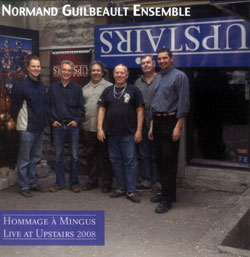
This group of Montreal musicians, led by double-bassist Norman Guilbeault, has spent quite some time at Charles Mingus' music. This is the second recording devoted to the late master's work, the previous being a studio outing, whereas this "Hommage a Mingus" features the sextet in a live setting, which heightens the intensity of the performances of this round of tunes.
There seems to be a love affair between Montreal and Mingus. Musicologist and band leader Andrew Homzy, author of Mingus: More than a Fake Book, was also the individual who dug through Mingus' archives to resurrect Epitaph, and local Uptown records' Bob Sunenblick released a bunch of previously unavailable Mingus Tracks (among them "Song with Orange" done here by the ensemble).
Guilbeault's team, which features some top-notch players from the local scene, among them Jean Derome (who appears on alto and bari saxes, flute and voice) and trumpeter and Montreal Off Festival founder Ivanhoe Jolicoeur, one of the city's most fiery players — are perfect choices for the Mingus charts.
The main treat of this album is that these are musicians who have a real feeling for the Mingus style and who pull it off fabulously with hot bluesy playing and off-the-beaten-track virtuosity. This is an unusual opportunity to hear Jean Derome on baritone saxophone, which, although not his usual horn, he plays with a lot of heart. Mathieu Belanger on clarinets, one of Montreal's best, contributes to the rich texture to the music, and the sextet is rounded out with the solid playing of Norman Deveault on piano and Claude Lavergne on drums. This CD also offers listeners the chance to hear one of Montreal's best jazz vocalists, Karen Young, on the chiaroscuro ballad "Weird Nightmare" and the impressionistic tone poem "Eclipse" which also has some nice chorale writing. The leader himself shines in passages where the bass takes the lead, as in the introduction to "Prayer for Passive Resistance", and when driving the spirited cacophony of "Sue's changes."
The transcriptions are faithful to the originals, but not pedantic, since these are all working musicians with individual styles which they bring to bear on their reading of the scores — scores that offer a good variety of material, representative of Mingus' abilities to elicit inside and outside playing. The recording reminds us of Mingus' importance as a composer and that, despite the loose aspect of his work-shopping approach which built on sketches for the players who took the music off with Mingus' presence, the spirit of Mingus lives despite his absence!
Comments and Feedback:



More Recent Reviews, Articles, and Interviews @ The Squid's Ear...


|

